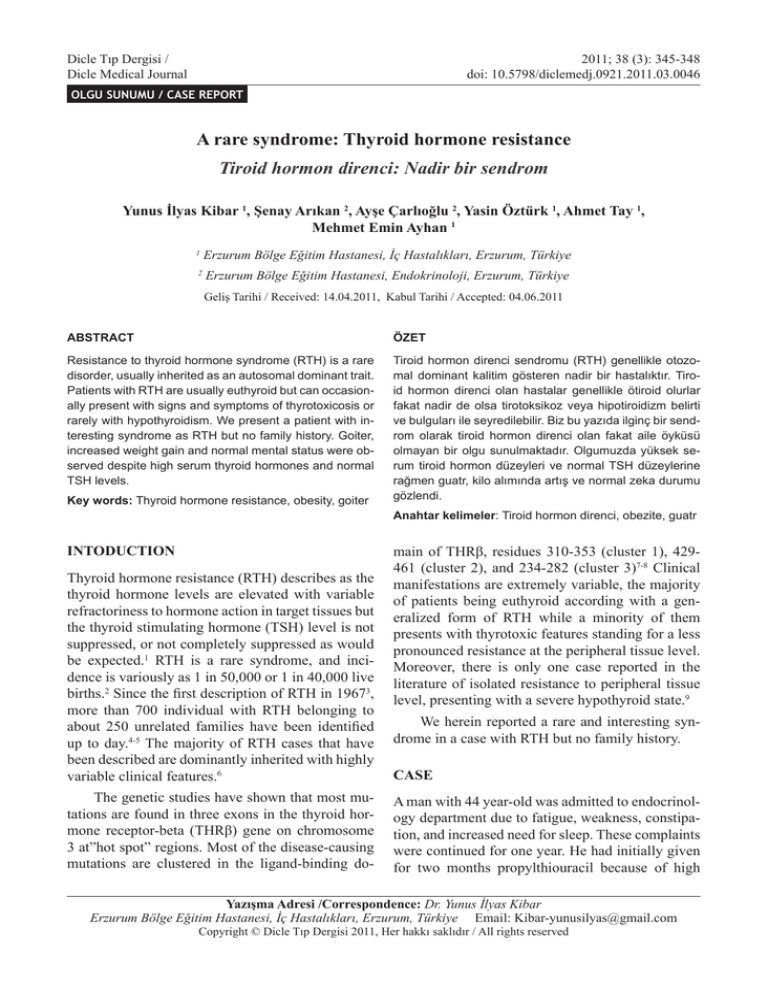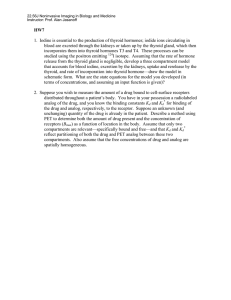
345
2011; 38 (3): 345-348
Y. İ. Kibar ve ark. A rare syndrome
doi: 10.5798/diclemedj.0921.2011.03.0046
Dicle Tıp Dergisi / Dicle Medical Journal OLGU SUNUMU / CASE REPORT
A rare syndrome: Thyroid hormone resistance
Tiroid hormon direnci: Nadir bir sendrom
Yunus İlyas Kibar 1, Şenay Arıkan 2, Ayşe Çarlıoğlu 2, Yasin Öztürk 1, Ahmet Tay 1,
Mehmet Emin Ayhan 1
1
Erzurum Bölge Eğitim Hastanesi, İç Hastalıkları, Erzurum, Türkiye
2
Erzurum Bölge Eğitim Hastanesi, Endokrinoloji, Erzurum, Türkiye
Geliş Tarihi / Received: 14.04.2011, Kabul Tarihi / Accepted: 04.06.2011
ABSTRACT
ÖZET
Resistance to thyroid hormone syndrome (RTH) is a rare
disorder, usually inherited as an autosomal dominant trait.
Patients with RTH are usually euthyroid but can occasionally present with signs and symptoms of thyrotoxicosis or
rarely with hypothyroidism. We present a patient with interesting syndrome as RTH but no family history. Goiter,
increased weight gain and normal mental status were observed despite high serum thyroid hormones and normal
TSH levels.
Tiroid hormon direnci sendromu (RTH) genellikle otozomal dominant kalitim gösteren nadir bir hastalıktır. Tiroid hormon direnci olan hastalar genellikle ötiroid olurlar
fakat nadir de olsa tirotoksikoz veya hipotiroidizm belirti
ve bulguları ile seyredilebilir. Biz bu yazıda ilginç bir sendrom olarak tiroid hormon direnci olan fakat aile öyküsü
olmayan bir olgu sunulmaktadır. Olgumuzda yüksek serum tiroid hormon düzeyleri ve normal TSH düzeylerine
rağmen guatr, kilo alımında artış ve normal zeka durumu
gözlendi.
Key words: Thyroid hormone resistance, obesity, goiter
INTODUCTION
Thyroid hormone resistance (RTH) describes as the
thyroid hormone levels are elevated with variable
refractoriness to hormone action in target tissues but
the thyroid stimulating hormone (TSH) level is not
suppressed, or not completely suppressed as would
be expected.1 RTH is a rare syndrome, and incidence is variously as 1 in 50,000 or 1 in 40,000 live
births.2 Since the first description of RTH in 19673,
more than 700 individual with RTH belonging to
about 250 unrelated families have been identified
up to day.4-5 The majority of RTH cases that have
been described are dominantly inherited with highly
variable clinical features.6
The genetic studies have shown that most mutations are found in three exons in the thyroid hormone receptor-beta (THRβ) gene on chromosome
3 at”hot spot” regions. Most of the disease-causing
mutations are clustered in the ligand-binding do-
Anahtar kelimeler: Tiroid hormon direnci, obezite, guatr
main of THRβ, residues 310-353 (cluster 1), 429461 (cluster 2), and 234-282 (cluster 3)7-8 Clinical
manifestations are extremely variable, the majority
of patients being euthyroid according with a generalized form of RTH while a minority of them
presents with thyrotoxic features standing for a less
pronounced resistance at the peripheral tissue level.
Moreover, there is only one case reported in the
literature of isolated resistance to peripheral tissue
level, presenting with a severe hypothyroid state.9
We herein reported a rare and interesting syndrome in a case with RTH but no family history.
CASE
A man with 44 year-old was admitted to endocrinology department due to fatigue, weakness, constipation, and increased need for sleep. These complaints
were continued for one year. He had initially given
for two months propylthiouracil because of high
Yazışma Adresi /Correspondence: Dr. Yunus İlyas Kibar
Erzurum Bölge Eğitim Hastanesi, İç Hastalıkları, Erzurum, Türkiye Email: Kibar-yunusilyas@gmail.com
TıpTıp
Derg
/ Dicle2011,
Med JHer
Cilthakkı
/ Vol 38,
No 3,/ 345-348
Copyright Dicle
© Dicle
Dergisi
saklıdır
All rights reserved
346
Y. İ. Kibar ve ark. A rare syndrome
free T3 (fT3) and free T4 (fT4) levels in other clinic,
but these complaints were increased. When he came
to our polyclinics, he had stopped propylthiouracil
treatment with his own decision since 6 months ago.
He has no prior history of hypothyroidism. There
were no chronic illnesses or previous thyroidal operation. In his family history, his father, mother, sisters and brothers do not have any thyroid disease.
Physical examination
The vital signs were blood pressure 120/70 mm
Hg, pulse 82/minute, respiratory rate 14/minute,
temperature 36.0° Celsius. His height was 165 cm
and his weight was 106 kg. He suffered obesity
and his body mass index was 39 kg/m2. He had a
nodular goiter (grade II). There was no neck tenderness. Hand fine tremor was not appreciated. Normal
deep tendon reflexes were observed. But, there were
markedly abdominal obesity and 2 cm hepatomegaly. Bowel sound was hypoactive. Other systemic
examinations were normal.
Laboratory values
Free T3 (fT3) and free T4 (fT4) levels were high,
but TSH level was not suppressed and, it was inappropriately normal level. Free T3 was found 7.5
pg/mL (normal range 1.8-4.2). Free T4 was found
3.27 ng/mL (normal range 0.8-1.9). TSH was found
3.19 mIU/mL (normal range 0.4-4.0). In spite of
the markedly elevated free T4 and free T3, the pa-
tient was clinically hypothyroid. TPO antibody was
<10.0 IU/mL ( normal range 0-35), thyroglobulin
was 11.16 ng/mL (normal range 1.15-35.0), antithyroglobulin was 20>IU/mL (normal range 0-40).
At thyroid ultrasound, his gland was viewed as a
heterogeneous and nodular pattern (5x5.5 mm in
right lobe, 6.6x9 mm in left lobe, respectively). In
the thyroid scintigraphy, the expected level of involvement and activity in both lobes were homogeneous. The anterior pituitary hormones as FSH,
LH, prolactin, growth hormone and fasting morning cortisol levels were normal range. In addition,
serum ferritin, total testosterone, free testosterone,
dehydroepiandrosterone sulfate, sex hormone binding globulin, and angiotensin-converting enzyme
levels were normal. Alpha subunit of TSH level was
0.30 IU/L in normal limit (normal range 0 to 0.80).
No pituitary TSH secreting adenoma (TSHoma)
was determined in pituitary MR by radiologists.
As a result, we considered thyroid hormone resistance and we performed TRH stimulation test. After
intravenous TRH injection bolus (400 ug), serum
TSH concentration increased from 1,40 U/mL to a
peak of 17,6 U/mL at 30 min (Table 1). In evaluation of echocardiography, presystolic ejection time
was observed as 52 msec below the normal range
(Figure 1). In this state, Refetoff syndrome (thyroid
hormone resistance) was considered and, levothyroxine 50 microgram per day was started. Later, his
complaints were reduced in the controls.
Figure 1. Presistolic ejection time in the patient
Dicle Tıp Derg / Dicle Med J Cilt / Vol 38, No 3, 345-348
Y. İ. Kibar ve ark. A rare syndrome
Table 1. Summary of pattern associated with elevated
TSH during TRH test
Time (min) TSH (mIU/mL) f T 3( pg/mL) f T4( ng/dL)
0
1.40
6.32
2.87
30
17.6
5.90
2.80
60
10.6
5.80
2.92
120
6.05
7.76
2.88
DISCUSSION
Thyroid hormone resistance is a rare disorder and
usually dominantly inherited manner with highly
variable clinical features. Characteristically, thyroid function tests are elevated free T4 and free T3
concentrations with inappropriately non-suppressed
TSH. The clinical expression of this syndrome is
heterogeneous. Exacerbate goiter is the most common clinical finding but the classic features include
cognitive ability, attention-deficit hyperactivity disorder, poor school performance, delays in growth
and development, hypercholesterolemia, signs of
hypothyroidism as deaf mutism, nystagmus, epiphyseal dysplasia, and delayed bone age and/or
tachycardia are usually diagnosed in childhood.
Our patient presented with markedly elevated thyroid hormone and normal TSH levels whereas a
mild RTH phenotype. In our case, diagnosis of RTH
has remained up to adulthood due to no significantly
clinical findings. His clinically features such as goiter, increased weight gain and normal mental status
were observed. It is important that many patients
with RTH are either asymptomatic or have nonspecific symptoms like our patient. The genetic heterogeneity in patients with RTH is the most likely
explanation for variable clinical findings.
Typically most or all tissues are resistant to thyroid hormone, so despite raised measures of serum
thyroid hormone the individual may appear euthyroid. Moreover, the severity of hormonal resistance
varies among different tissues in an affected individual, and also varies among different subjects carrying the same gene mutation. The reasons for this
variability are poorly understood. According to our
findings, the only index case presented with elevated TSH and no symptoms of hypothyroidism, but
other his family members were asymptomatic and
phenotypes were normal. In physical examination,
goiter was the most significantly clinical abnormal-
347
ity in our patient. This finding pointed out that high
serum TSH levels with increased biological activity
might be responsible for the goiter and maintenance
of high thyroid hormone levels in RTH. He has normal thyroid hormone levels and normal TSH while
taking 100 mg L-T4 per day.
Sinus tachycardia is very common in patients
with RTH, some studies reporting frequency as
high as 80%12 One previously study13 showed mild
tachycardia in RTH patients with an average resting heart rate of 83 beats/min (range 57-107). The
liver and pituitary express predominantly TRβ1 and
TRβ2 respectively, whereas myocardium expresses
TRα1. Therefore mutations in the TRβ gene in RTH
are associated with pituitary and liver resistance, as
exemplified by normal serum sex-hormone-binding
globulin and non-suppressed TSH levels seen in
patients, while the tachycardia seen in many RTH
cases may represent retention of cardiac sensitivity
to elevated thyroid hormones acting via a normal
TRα.15 Interestingly, although positive correlations
between free T3 and heart rate have been shown in
RTH, heart rate was clearly normal range in spite
of high free T3 levels in our index case. Moreover,
normal presystolic ejection time was demonstrated
during echocardiographic evaluation. According to
our finding, cardiac affects of RTH were negligible
in our case.
Neurophysiological abnormalities such as attention deficit hyperactivity disorder in childhood or
language development problems manifested by poor
reading skills, dyslexia and problems with articulation have been documented in a large number of
patients with RTH.4,10,11 But, these neurophysiological symptoms were not determined in our patient;
his only symptom of RTH was obesity. Obesity was
much more pronounce than cases of heterozygous
RTH. Moreover, his obesity has worsened due to cessation of LT4 drug treatment over a 6-month period.
His weight was increase approximately 12 kg in 6
months. Mitchell CS et al.14 recently demonstrated
that energy intake in RTH subjects was increased by
40%, with marked hyperphagia particularly evident
in children. Basal mitochondrial substrate oxidation
is increased and energy production in the form of
ATP synthesis is decreased in the muscle of RTH
patients and that resting oxidative phosphorylation
is uncoupled in this disorder.14
Dicle Tıp Derg / Dicle Med J Cilt / Vol 38, No 3, 345-348
348
Y. İ. Kibar ve ark. A rare syndrome
At least three different molecular alterations
may cause reduced sensitivity to thyroid hormones:
(a) mutations in the gene encoding TRβ isoform
causing RTH, (b) mutations of the specific TH transporter, monocarboxylate transporter 8 (MCT8), and
(c) mutations in selenocysteine insertion sequence
binding protein 2 (SECISBP2) which reduces the
synthesis of selenoproteins, including the TH deiodinases.16 Kale BK et al.17 previously demonstrated
that a Turkish family with RTH whose proband a
19-year-old male, presented with diffuse goiter,
nervousness, and palpitation. Gene sequencing
revealed a mutation in one allele of the TRβ gene
in the proband, his two brothers, and father. It involved the substitution of the normal cytosine 1642
with a thymidine, resulting in the replacement of
the normal proline 453 with a serine (P453S) in the
T3-binding domain of the TRβ. Unfortunately, we
could not evaluate to genetic mutations in this family because of technical failure.
In conclusion, routine investigation by sensitive TSH may provide to detect a greater number
of patients in outpatient’s clinics. It is important to
remember that the patients with RTH may display
only minimal elevation of serum TSH despite high
thyroid hormones levels.
REFERENCES
1. Berker D, Aydin Y, Tutuncu YA, Isik S, Delibasi T, Berker M,
Guler S, Kamel N. Somatotropin adenoma and resistance to
thyroid hormone. J Endocrinol Invest 2009;32(3):284-6.
2. Refetoff S, Dumitrescu AM . Syndromes of reduced sensitivity to thyroid hormone: genetic defects in hormone receptors, cell transporters and deiodination. Best Pract Res Clin
Endocrinol Metab 2007;21:277-305.
3. Wong GWK, Shek CC, Lam STS, Tsui MKM, Leung SSF.
Detection of resistance to thyroid hormone by cord blood
screening. Acta Pediatr 1995;84:335-6.
4. Refetoff S, DeWind LT, DeGroot LJ. Familial syndrome
combining deaf-mutism, stippled epiphyses, goiter and abnormally high PBI: possible target organ refractoriness to
thyroid hormone. J Clin Endocr 1967;27:279-94.
5. Refetoff S, Weiss RE, Usala SJ. The syndromes of resistance
to thyroid hormone. Endocrine Reviews 1993;14:348-99.
6. Snyder D, Sesser D, Skeels M, Nelson G, LaFranchi S. Thyroid disorders in newborn infants with elevated screening
T4. Thyroid abstract 7, suppl 1997;1:S-29.
7. Beck-Pecooz P & Chatterjee VKK. The variable clinical phenotype in thyroid hormone resistance syndrome. Thyroid
1994;4 (2):225-232.
8. Weiss R, Refetoff S. Resistance to thyroid hormone. Rev Endocr Metab Disord 2000;1(2):97-108.
9. Collingwood TN, Wagner R, Matthews CH, et al. A role for
helix 3 of the TR beta ligand-binding domain in co-activator recruitment identified by characterization of a third cluster of mutations in resistance to thyroid hormone. EMBO J
1998;17(12):4760-70.
10. Kaplan MM, Swartz SL and Larsen PR. Partial peripheral
resistance to thyroid hormone. Am J Med 1981;70(11):11151121.
11. Chatterjee VKK, Beck-Peccoz P. Thyroid homone resistance. Bailliere’s Clinical Endocrinology and Metabolism
1994;8:267-283.
12. Brucker-Davis F, Skarulis MC, Grace MB, Benichou J,
Hauser P, Wiggs E et al. Genetic and clinical features of 42
kindreds with resistance to thyroid hormone. The National
Institutes of Health prospective study. Annals of Internal
Medicine 1995;123:572-83.
13. Beck-Pecooz P, Chatterjee VKK. The variable clinical phenotype in thyroid hormone resistance syndrome. Thyroid
1994;4:225-32.
14. Kahaly G, Matthews C, Mohr-Kahaly S, Richards CA,
Chatterjee VKK. Cardiac involvement in thyroid hormone
resistance. J Clin Endocrinol Metabolism 2002;87:204-12.
15. Mitchell CS, Savage DB, Dufour S, et al. Resistance to thyroid hormone is associated with raised energy expenditure,
muscle mitochondrial uncoupling, and hyperphagia. J Clin
Invest 2010; 120(4):1345-54.
16. Chatterjee VK. Resistance to thyroid hormone, and peroxisome-proliferator-activated receptor gamma resistance.
Biochem Soc Trans 2001;29:227-31.
17. Refetoff S, Dumitrescu AM. Syndromes of reduced sensitivity to thyroid hormone: genetic defects in hormone receptors, cell transporters and deiodination. Best Pract Res
Clin Endocrinol Metab 2007;21:277-305.
18. Kale Köroğlu B, Mamanasiry S, Küçük A, Tamer MN,
Yılmaz R, Refetoff S. Resistance to thyroid hormone: Probable de novo mutation (P453S) in the receptor beta gene.
Turk J Endocrinol Metabol 2009; 13(3):43-6.
Dicle Tıp Derg / Dicle Med J Cilt / Vol 38, No 3, 345-348





![Anti-TSH antibody [TSH-116] ab767 Product datasheet 1 References Overview](http://s2.studylib.net/store/data/013145164_1-af63fcdcd8aa2e49793222ddace32fb3-300x300.png)